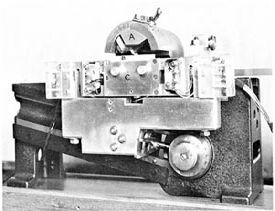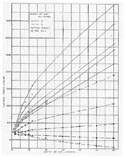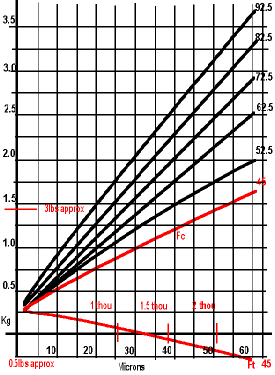

The illustrations and graphs are taken from Forest Products Research Special Report No. 14 'Experiments in Rectilinear Cutting' (Part 1), HMSO , London 1960, KJS Walker and R Goodchild.

The apparatus was made from a sledge type of microtome. The cutter head (A above) is adjustable. The sledge can be moved at speeds varying between 8.5 and 11.5 feet/min (2.6 and 3.5 m/min). This, of course is much slower than a normal hand planing speed.
The cutter is 0.2in (5.08mm) wide
The transducers at each extremity measure Fc, the horizontal cutting force and the vertical sensing transducers measure the vertically orientated force Ft. Ft is taken as positive when it acts downwards into the wood.

1 kg = 2.2 lbs
1 inch = 25.4 mm
1 micron = 0.001 mm
1 thou = 0.001 inch
The report measured the cutting forces in grams and measured the cutting angle as an angle from the vertical.
The sharpening angle of the cutter does not appear to have been given. They say that the edge thickness would be in the region of 1 to 2 microns.
Note that this system produces 'riven' shavings. There is no pressure applied to the wood surface such as that from a plane with a fine shaving aperture. Intuition suggests that for a plane with a fine shaving aperture, the cutting force will be increased.
Please see:Coping With Gnarly Grain.
I assume that most of us will be happier working in force units (kilograms or pounds force) that we can relate to (unlike scientifically-correct 'Newtons').
Hand plane cutting angles are usually measured from the worksurface, so these angles are given here.

Right:The graph was traced from the report.
For simplicity, the curves for Ft (apart from the estimated curve at 45deg cutting angle) are omitted.
Unfortunately, the experimenters did not reduce the cutting angle to 45deg, so the red curve was interpolated by looking at the intercepts on the 60micron line. (However, for flat-sawn beech (see left) they are not so predictably spaced).
Figures in red are interpolated values.
Assuming that these figures do relate to the operation of a hand plane: it appears that the cutting force on a 0.2in wide cutter, say a plough blade, when cutting a fairly hefty two-thou shaving in quarter sawn beech could be somewhere in the region of 3lbs.
If the shaving thickness is about one and a quarter thou, the cutter begins to pull itself into the wood.
